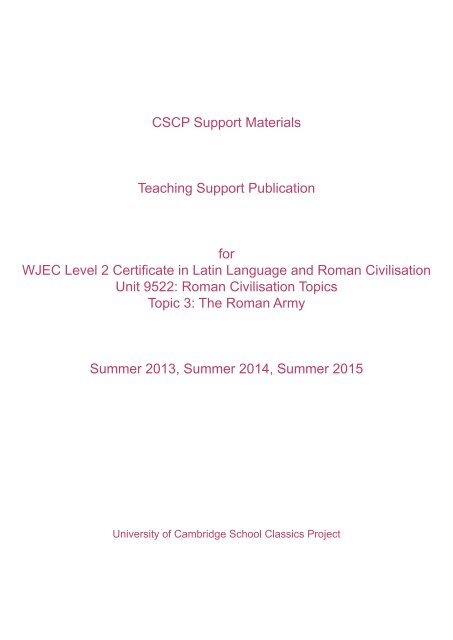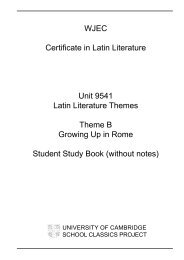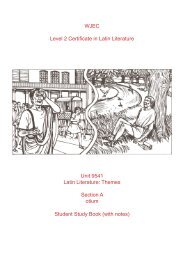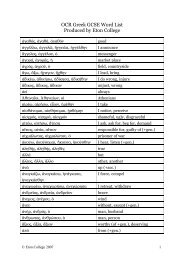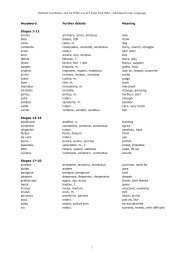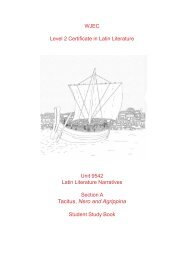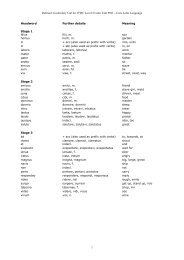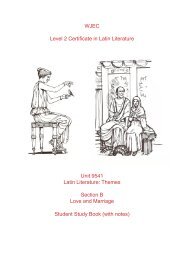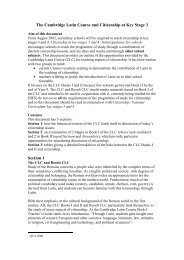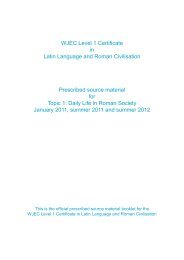PDF version (36MB) - Cambridge School Classics Project
PDF version (36MB) - Cambridge School Classics Project
PDF version (36MB) - Cambridge School Classics Project
You also want an ePaper? Increase the reach of your titles
YUMPU automatically turns print PDFs into web optimized ePapers that Google loves.
CSCP Support MaterialsTeaching Support PublicationforWJEC Level 2 Certificate in Latin Language and Roman CivilisationUnit 9522: Roman Civilisation TopicsTopic 3: The Roman ArmySummer 2013, Summer 2014, Summer 2015University of <strong>Cambridge</strong> <strong>School</strong> <strong>Classics</strong> <strong>Project</strong>
Published By the <strong>Cambridge</strong> <strong>School</strong> <strong>Classics</strong> <strong>Project</strong>Faculty of Education, University of <strong>Cambridge</strong>11 West Road, <strong>Cambridge</strong> CB3 9DP, UKhttp://www.<strong>Cambridge</strong>SCP.com© University of <strong>Cambridge</strong> <strong>School</strong> <strong>Classics</strong> <strong>Project</strong>, 2011CopyrightIn the case of this publication, the CSCP is waiving normal copyright provisions in that copies of thismaterial may be made free of charge and without specific permission so long as they are for educationalor personal use within the school or institution which downloads the publication. All other forms of copying(for example, for inclusion in another publication) are subject to specific permission from the <strong>Project</strong> and/orthe third party holders of the copyright of the particular images or sources.First published 2011AcknowledgementsThanks are due to the following for permission to reproduce photographs:P.7, p.8 bottom left, p.8 bottom right, p.10 left, p.10 right, p.11 bottom, p.14 top, p.15 bottom left, p.16 top left, p.16 top right,p.16 bottom, p.18 top, p. 33, VL Walden; p.11 top left, p.15 bottom right, National Museums Scotland; p.13 top, p.14 bottom,p.24 right, Landesmuseum Mainz; p.24 left, M Duguin; p.25, p.27 top, p.29 top, p.34, p.35, p.36 left, p.36 right, CSCP; p.27bottom, ML Design; p.28 top, Pictorial Colour Slides; p.28 middle, D Swarbrick; p.28 bottom, Skyscan; p.29 bottom, p.30top, Roger Wilson; p.30 bottom, English Heritage; p.31 top, p.31 bottom, J Lashly.Other photography by RL Dalladay.
ContentsIntroduction........................................................................................................................................................... 4Recruitment and training................................................................................................................................. 5Weapons and equipment................................................................................................................................. 9Daily duties............................................................................................................................................................................17Pay and promotion........................................................................................................................................... 21The legionary fortress.................................................................................................................................................... 26Military tombstones......................................................................................................................................... 32WJEC Level 2 Certificate in Latin Language and Roman Civilisation: The Roman Army 3
IntroductionThis booklet of sources on The Roman Army is intended to support teachers and students preparing for Topic 3 of theWJEC Level 2 Certificate in Latin Language and Roman Civilisation.Important notice: the purpose and status of this bookletThe purpose of this booklet is to provide teachers with a wide range of sources for their teaching. It should thereforebe considered only as a teaching support publication. At Level 2 such booklets are not intended to be definitivecatalogues of sources which may be used in the examination and students should not attempt, nor be encouraged, to‘rote learn’ the sources contained within. Although examiners may use some of the sources in the booklets, other similarsources may also be used in the Level 2 examination.Likewise, teachers should feel under no obligation to study any or all of the sources contained herein with theirstudents.Note on differences between Level 1 and Level 2Different regulations apply at Level 1 and Level 2. At Level 1, shorter booklets containing a restricted number of sourcesare available. The Level 1 examination papers will use only sources from the Level 1 booklets. Please visit the WJECwebsite, or the Level 1 area of this website, for the Level 1 booklets.Relevant Stages of the <strong>Cambridge</strong> Latin CourseBook III of the <strong>Cambridge</strong> Latin Course and the accompanying Teacher’s Guide contain primary source material, togetherwith explanatory texts, to support this topic:Stage 25: The legionary soldierStage 26: The senior officers in the Roman army; Agricola, governor of BritainStage 27: The legionary fortressStage 28: Interpreting the evidence (esp. inscriptional evidence)4 WJEC Level 2 Certificate in Latin Language and Roman Civilisation: The Roman Army
Recruitment and trainingWJEC Level 2 Certificate in Latin Language and Roman Civilisation: The Roman Army 5
Vegetius 1.6A young soldier should have alert eyes and should hold his head upright. The recruit should be broadchestedwith powerful shoulders and brawny arms. His fingers should be long rather than short. He shouldnot be pot-bellied or have a fat bottom. His calves and feet should not be flabby: instead they should bemade entirely of tough sinew.In choosing or rejecting recruits, it is important to find out what trade they have been following. Fishermen,birdcatchers, sweetmakers, weavers and all those who do the kind of jobs that women normally do should bekept away from the army. On the other hand, smiths, carpenters, butchers and hunters of deer and wild boarare the most suitable kind of recruit. The whole wellbeing of the Roman state depends on the kind of recruitsyou choose; so you must choose men who are outstanding not only in body but also in mind.P. Oxy. VII.1022 letterCopy C. Minucius Italus to CelsianusGive instructions that the six recruits approved by me for the cohort under your command be entered on therecords with effect from 19 th February. I have appended their names and distinguishing-marks to this letter.C. Veturius Gemellus aged 21 no distinguishing marksC. Longinus Priscus aged 22 scar on left eyebrowC. Julius Maximus aged 25 no distinguishing marks-. Julius Secundus aged 20 no distinguishing marksC. Julius Saturninus aged 23 scar on left handM. Antonius Valens aged 22 scar on right side of foreheadReceived 24 th February 103AD, through Priscus, singularis. I, Avidius Arrianus, cornicularius of Cohors IIIIturaeorum, state that the original letter is in the records office of the cohort.Sallust, Jugurthine War 86Marius enlisted recruits not in the traditional manner nor on the basis of property qualification, but taking anycitizen who chose to volunteer, property-less men for the most part.Pliny, Letters 10.38 adaptedGaius Plinius to Emperor TrajanSempronius Caelianus, an outstanding young man, sent me two slaves discovered among the recruits. Ipostponed their punishment in order to consult you, the founder and upholder of military discipline, about thekind of punishment. For I myself am hesitant especially because, although these slaves had already takenthe military oath, nevertheless they had not yet been distributed to their military units. I, therefore, ask, sir,that you write saying what I should do, especially since it involves a precedent.Pliny, Letters 10.39 adaptedTrajan to PlinySempronius Caelianus acted in accordance with my orders by sending you those slaves concerning whomit will be necessary to find out whether they seem to have deserved capital punishment. But it does makea difference whether they offered themselves as volunteers or were conscripted or even were sent assubstitutes. If they were conscripted, the military investigation was at fault; if they were given as substitutes,the fault is with those who gave them; if they themselves came, although they had knowledge of their status,they will have to be punished. For it makes little difference that they have not yet been assigned to theirunits. For that day on which they were first examined required from them the truth of their status.CPL 102Titus Flavius Longus, optio of Legion III Cyrenaica, in the century of Arellius, made a declaration and gaveas guarantors ... Fronto, in the century of Pompeius Reg... and Lucius Longinus Celer in the century ofCre..., and Lucius Herennius Fuscus, veteran, and stated on oath that he was freeborn and a Roman citizen,and had the right of serving in a legion.Whereupon his guarantors declared on oath by Jupiter Best and Greatest and the spirit of Emperor CaesarDomitian Augustus, Conqueror of the Germans that he was freeborn and a Roman citizen and had the rightof serving in a legion.Transacted in the Augustan camp in the winter-quarters of the Third Legion, the seventeenth year of EmperorCaesar Domitian Augustus, Conqueror of the Germans, in the consulship of Quintus Volusius Saturninus andLucius Venuleius Montanus Apronianus.6 WJEC Level 2 Certificate in Latin Language and Roman Civilisation: The Roman Army
Arrius Menander, On Military Affairs IIt is considered a serious crime for someone to enlist as a soldier if he is not permitted to do so, and thegravity is increased, as in other offences, by the dignity, rank and type of military service.Combat trainingVegetius 1.11The Romans train their recruits in the following way. They equip them with round shields woven from willowsaplings and weighing twice as much as those used on the battlefield. They also give them wooden swordsdouble the weight of real ones. So they are able to defend themselves better and to attack more vigorously.They are made to exercise in the afternoons as well as in the mornings, using this equipment against awooden post.This is an invention which gives valuable training to gladiators as well as to soldiers. No man has everdistinguished himself either in the arena or on the battlefield without first going through a rigorous training atthe post.This is what the recruit does. He fixes a post about six feet in height firmly in the ground. He then practisesfighting against the post, as if he is fighting an enemy. He uses his woven shield and wooden sword, as if heis using real ones. First, he attacks his opponent's head and face, then he goes for his sides and sometimeshe attempts to hack at his thighs or legs. He steps back or thrusts forward this way and that as if fightinga real opponent, using every manoeuvre possible. Most important of all the training he receives is that helearns never to expose any part of his body to his opponent while aiming his own blows at him.Valerius Maximus 2.3.2The consul Publius Rutilius broke new ground not covered by any previous commander by calling ininstructors from the gladiatorial school of Gaius Aurelius Scaurus to train his legionaries in a more skilfultechnique of weaponry, both in attack and in defence.Josephus, The Jewish War 3.102-104By their military exercises the Romans instil into their soldiers fortitude not only of body but also of soul; fear,too, plays its part in their training. For they have laws which punish with death ... even a slight neglect of duty.Hadrian, speech to Sixth Cohort Commagenorum, ILS I.2487I approve of the legate’s introduction of this form of drill which gave the impression of real fighting and sotrains you effectively.WJEC Level 2 Certificate in Latin Language and Roman Civilisation: The Roman Army 7
Vegetius, 1.9At the beginning of their training recruits must be taught themarching step. They will only learn to march quickly and intime if they practise continuously. And so they must completea march of 20 (Roman) miles in 5 hours at normal marchingspeed. When they march at a faster speed they mustcomplete a distance of 24 miles in the same time.Vegetius, 1.19The young soldier must be given frequent practice in carryingloads of up to 60 pounds, while marching at the normalspeed. This is because on difficult campaigns they will haveto carry their rations as well as their weapons.Soldiers marching with their kitJosephus, The Jewish War 3.72-6Indeed, as if they had been born fully armed they never take a holiday from training and do not wait for crises toappear. Their training manoeuvres lack none of the vigour of genuine warfare and each soldier practises battle drillevery day with great enthusiasm just as if he were in battle. Therefore they sustain the shock of combat very easily.For their usual well-ordered ranks are not disrupted by any confusion, or numbed by fear, or exhausted by toil; so,certain victory inevitably follows since the enemy cannot match this. Indeed one would not be wrong in saying thattheir training manoeuvres are battles without bloodshed, and their battles manoeuvres with bloodshed.Cavalry training8 WJEC Level 2 Certificate in Latin Language and Roman Civilisation: The Roman Army
Weapons and equipmentWJEC Level 2 Certificate in Latin Language and Roman Civilisation: The Roman Army 9
Josephus, The Jewish War 3.93-7The men move forward all marching in silence and in good order. Each man keeps his own position as if hewere fighting.Foot-soldiers are armed with a cuirass and a helmet. They carry two swords, one on each side. The oneon the left is much longer than the other. The one on the right is not much more than a span in length. Thesoldiers chosen to form the general's bodyguard carry a spear and a round shield. The ordinary soldiercarries a javelin and a tall oblong shield. In addition, he carries a saw, a basket, a mattock and an axe, aswell as a leather strap, a sickle, a chain, and enough rations to last him for three days. In fact he carries somuch equipment that he is not very different from a pack-mule.Cavalrymen wear a long sword on the right and hold a long thrusting spear in the hand. They have a largeshield which rests on the horse's back and a quiver with three or more weapons for throwing, which havebroad points and are as long as spears. Their helmets and cuirasses are the same as those worn by all thefoot-soldiers. The cavalrymen who have been chosen to form the general's bodyguard are armed in exactlythe same way as the rest of the cavalry.The legion which is to lead the marching column is always chosen by lot.Josephus, The Jewish War 1.12They are also taught not to cut with their swords but to thrust. The Romans find it so easy to beat people whouse their swords to cut rather than thrust that they laugh in their faces. For a cutting stroke, even when madewith full force, rarely kills. The vital organs are protected by the armour as well as by the bones of the body.On the other hand, a stab even two inches deep is usually fatal. So you have to make sure that whatever youcut the body with goes in far enough to reach the vital organs. Besides, if you attempt to cut rather than thrustwith your sword, you expose your right arm and side. Yet when you deliver a thrust the body is protected andthe enemy is wounded before he even sees the sword. This is the method of fighting that the Romans chieflyuse.Personal equipmentLegionary10 WJEC Level 2 Certificate in Latin Language and Roman Civilisation: The Roman Army
Sword blade, found at Newstead,ScotlandDagger and sheath, found atHod Hill, DorsetLegionaries advancing in combatWJEC Level 2 Certificate in Latin Language and Roman Civilisation: The Roman Army 11
Parade, Column of Antoninus PiusRoman soldiers, Trajan’s Column12 WJEC Level 2 Certificate in Latin Language and Roman Civilisation: The Roman Army
Two soldiers, relief found in MainzTestudo, Trajan’s ColumnVindolanda tabletI have sent you some pairs of socks from Sattua, two pairs of sandals and two pairs of underpants.WJEC Level 2 Certificate in Latin Language and Roman Civilisation: The Roman Army 13
Ermine Street GuardImaginifer tombstone, MainzPliny, Natural History 10.16In his second consulship, Marius made the eagle the special standard of the Roman legions. It had previouslybeen the chief standard, but there were also four others: the wolf, the minotaur, the horse and the boar werecarried before the individual ranks. A few years earlier the custom had begun of learning all these behind in campand carrying the eagle alone in to battle; Marius discarded them altogether.14 WJEC Level 2 Certificate in Latin Language and Roman Civilisation: The Roman Army
Auxiliary soldiers, Trajan’s ColumnRoman cavalryA cavalrymanWJEC Level 2 Certificate in Latin Language and Roman Civilisation: The Roman Army 15
ArcherBallistaOnager16 WJEC Level 2 Certificate in Latin Language and Roman Civilisation: The Roman Army
Daily dutiesWJEC Level 2 Certificate in Latin Language and Roman Civilisation: The Roman Army 17
Marching with equipmentFestus 267L'Marius' mules' is a name that derives from a practice of Marius, who accustomed his soldiers to labour alongcarrying their own baggage on a kind of hod.Vegetius, 2.11A legion has builders, carpenters, masons, blacksmiths, painters and all the rest of the craftsmen who are neededto build the winter quarters, to make equipment, towers, fences and siege machinery, and who build and repairweapons, waggons, and all kinds of artillery. There are workshops for shields, breast-plates and bows, where theyalso make arrows, missiles, helmets and all other types of armour. They are very concerned that whatever thearmy needs should always be available in the camp.Legionary working with a pickaxe,found in Bonn, GermanyFetching water and felling trees, Trajan’s Column18 WJEC Level 2 Certificate in Latin Language and Roman Civilisation: The Roman Army
Josephus, The Jewish War III.85-93Once they are encamped, the soldiers take up their quarters in tents, unit by unit. They do this quietly and inan orderly manner. They carry out all their other duties in the same way with the same discipline and attentionto safety. This also applies when they go to collect wood, food supplies and the water they need. These jobsare shared out among the men. They do not have their supper or breakfast at any time they fancy, but they alleat at the same time. The time for going to bed, for beginning guard duty and for getting up are all announcedby the sound of a trumpet, and nothing is done without a word of command. At dawn the ordinary soldiersreport to their centurions. The centurions then go to salute the tribunes. The tribunes with the other officersthen go to the legate for the morning salutation. The legate gives the officers the watchword and other orderswhich are to be passed on to the lower ranks. They act in the same organised way on the battlefield; whetherthey are on the attack or in retreat, the troops wheel round sharply in formation in the direction required assoon as the order is given.Constructing a camp, Trajan’s ColumnVegetius, 2.10The camp prefect has many important responsibilities. He must choose a site for a camp and mark out the walland ditch. He must organise the tents or soldiers' barracks along with their baggage. He is also responsiblefor seeing that medical treatment is available for sick soldiers. He must also see that the following itemsare always available: waggons, mules, saws, axes, spades, chisels, wood, straw, battering rams, onagers,ballistae, and every other type of siege machinery.As the most knowledgeable man, he is chosen for the job after many years' outstanding service. He can thenteach others what he has done well himself.Medical treatment, Trajan’s ColumnWJEC Level 2 Certificate in Latin Language and Roman Civilisation: The Roman Army 19
Pliny, Letters X.19Master, I do not know what to do. So I ask you to give me some direction. Should I let public slaves be prisonofficers? This is what they have done up to now. Or should I use Roman soldiers for this? Public slaves donot make the best prison officers. But you would need a fair number of soldiers to do the job. For the timebeing, I have added a few soldiers to the slaves. There is a danger that neither the soldiers nor the slaveswill do the job properly. If they both do it, they may have enough cheek to blame each other.Name 1st Oct 2nd Oct 3rd Oct 4th Oct 5th Oct 6th Oct 7th Oct 8th Oct 9th Oct 10th OctC DomitiusCelerC AemiliusValensHelius’bootsLatrinesLeave by prefect’spermissionCotton Armoury Baths CattleC Julius Valens Training Tower Drainage Boots Armoury Baths Century BathsC JuliusOctavianusP ClodiusSecundusAsbeforeCampmarketCentury Baths PrincipiaguardGateguardM Arrius Niger Century CamproadsL SextiliusGermanusGateguardC Julius F... Artillery WatchtowerQ CassiusRufusC Julius LongusSidoC Julius LongusAvsoT FlaviusPriscusT Flavius NigerM AntoniusCrispusM Num...IslandCampmarketAsbeforeTribuneescortStandards Baths Tower DDecrius’centuryBootswithAsiniusBaths Stretchers Century PlainclothesPrincipiaguardSerenus’centuryRampartguardCenturyCenturyHelius’centuryQ Petronius Baths CampmarketDuty roster, Egypt, 1st century ADTribuneescortRoadpatrolBootsRoadpatrolCenturyHelius’bootsCenturyCentury20 WJEC Level 2 Certificate in Latin Language and Roman Civilisation: The Roman Army
Pay and promotionWJEC Level 2 Certificate in Latin Language and Roman Civilisation: The Roman Army 21
Diagram of a legionRMR 68, papyrus, OxyrhynchusIn the consulship of Lucius AsiniusQuintus Julius Proculus from Damascusreceived the first salary instalment of the third year of the Emperor,247½ drachmas, out of whichhay10 drachmasfor food80 drachmasboots, socks12 drachmasSaturnalia of the camp20 drachmas? 60 drachmastotal expenditure182 drachmasbalance deposited to his account 65½ drachmasand had from before136 drachmasmakes a total of201½ drachmas22 WJEC Level 2 Certificate in Latin Language and Roman Civilisation: The Roman Army
ILS 2658, tombstone from Kasserine in TunisiaPetronius Fortunatus served for fifty years, four in Legion I Italica as clerk, officer in charge of watchword,orderly (optio), standard-bearer; he was promoted to centurion by the vote of the legion, served as centurionof Legion I Italica, centurion of Legion VI Ferrata, centurion of Legion I Minervia, centurion of Legion XGemina, centurion of Legion III Gallica, centurion of Legion XXX Ulpia, centurion of Legion VI Victrix,centurion of Legion III Cyrenaica, centurion of Legion XV Apollinaris, centurion of Legion II Parthica, centurionof Legion I Adiutrix; in the Parthian expedition he was decorated for bravery with a Wall and Rampart Crownand with necklaces and ornaments; he was in his eightieth year at the completion of this ornament forhimself and for Claudia Marcia Capitolina, his beloved wife, who was in her sixty-fifth year at the time of thecompletion of this monument, and for his son, Marcus Petronius Fortunatus, who served in the army for sixyears, centurion of Legion XXII Primigenia, centurion of Legion II Augusta, lived 35 years; for their belovedson, Fortunatus and Marcia, his parents, built this as a memorial.Smallwood GN 283, tombstone from Rimini in ItalyTo Marcus Vettius Valens, son of Marcus, of the Aniensis tribe, soldier of the Eighth Praetorian Cohort, clerkof the praetorian prefect, decorated in the British war with necklaces, armbands and ornaments, reservist ofthe Emperor, decorated with a Gold Crown, centurion of the Sixth Cohort, trainer of the cavalry scouts, chiefof the headquarters, centurion of Legion XIII Gemina from the post of trecenarius, chief centurion of LegionVI Victrix, decorated for his successful exploits against the Astures with necklaces, armbands and ornaments,tribune of the Fifth Cohort of vigiles, tribune of the Twelfth Urban Cohort, tribune of the Third PraetorianCohort, chief centurion for the second time of Legion XIV Gemina Warlike Victorious, procurator of EmperorNero Caesar of the province of Lusitania, patron of the colony, ten scouts (set this up) in his honour, in theconsulship of Gaius Luccius Telesinus and Gaius Suetonius Paulinus.Inscription from Philippi in GreeceTiberius Claudius Maximus, veteran, undertook the construction of this monument while he was still alive.He served as a cavalryman in Legion VII Claudia Loyal and Faifthful, was appointed treasurer of the cavalry,guard of the commander of the same legion, standard-bearer of the cavalry, and in the Dacian war wasawarded military decorations for bravery by Emperor Domitian. He was promoted to ‘double pay’ soldier inthe second ala of Pannonians by the divine Trajan, by whom he was also appointed to the position of scout inthe Dacian war, and twice awarded military decorations for bravery in the Dacian and Parthian wars, and waspromoted decurion in the same cavalry ala by the same emperor because he had captured Decebalus andbrought his head back to him at Ranisstorum. After voluntarily serving beyond his time, he was honourablydischarged by Terentius Scaurianus, commander with consular rank of the army in the new province ofMesopotamia.Standard bearers from Trajan’sColumnWJEC Level 2 Certificate in Latin Language and Roman Civilisation: The Roman Army 23
Tombstone of a centurionTombstone of an aquiliferP. Mich. 466, Julius Apollinarius to Julius SabinusThings are fine with me ... while others were breaking stones all day and doing other things, up until today Ihave suffered none of this. In fact I asked Claudius Severus, the governor, to appoint me as a clerk on his staff,and he said, ‘There is no vacancy; nevertheless in the meantime I shall appoint you as a clerk of the legion withexpectation of advancement’. With this appointment I went from the governor and commander of the legion to thesenior clerk.Suetonius, On Grammarians 24Marcus Valerius Probus of Berytus, for a long time tried to obtain an appointment as a centurion until he becametired of waiting and devoted his attention to study.Pliny, Letters VI.25I suspect the same thing has happened to him as happened to Metilius Crispus, who came from Comum. I hadgot him promoted to the rank of centurion. When he went off from here to Rome, I gave him 40 000 sesterces. Hewas going to buy his uniform and fit himself out. But after he had gone, I never had a letter from him.Tacitus, Annals 1.23The centurion Lucilius lost his life. In army banter his name was ‘gimme another’, because every time he broke hisstick on a soldier’s back he shouted for another, and another.24 WJEC Level 2 Certificate in Latin Language and Roman Civilisation: The Roman Army
Tombstone of an optio, from ChesterOPTIONIS AD SPEMORDINIS C LUCILIINGENUI QUINAUFRAGIO PERITS E(Tombstone) of an optio, waiting forpromotion to the rank of centurion[C], serving in the century of LuciusIngenuus, who died in a shipwreck. Heis buried ...Josephus, The Jewish WarCalling up each by name he [Titus] applauded them as they came forward, no less exultant over their exploitsthan if they were his own. He then placed crowns of gold upon their heads, presented them with golden neckchains,little golden spears and standards made of silver, and promoted each man to a higher rank; he furtherassigned to them out of the spoils silver and gold and raiments and other booty in abundance.Augustus, Res Gestae 15I gave 1000 sesterces out of booty to each of the colonists who had been one of my soldiers; about 120 000men in the colonies received this gift at the time of my triumph.Augustus, Res Gestae 17The military treasury was set up on my advice to pay discharge benefits to soldiers who had served twentyyears or more. In the consulship of Marcus Lepidus and Lucius Arruntius (AD 6), I transferred 170 000 000sesterces from my own property to it.Tacitus, Annals 1.17Percennius, leader of the mutineers in Pannonia said that enough harm had been caused over the yearsby their passivity; old men, several of them with their bodies disfigured by wounds, were serving theirthirtieth or fourtieth year. There was no end to military service even when they were discharged, since theyremained under the standards and performed the same toil under another name. And, if anyone survivedall these perils, he was dragged of to a distant country where he received under the name of a plot of landwaterlogged swamps or uncultivated mountainsides. Indeed military service was relentless and unprofitable;body and spirit were valued at two and a half sesterces a day, and out of this they had to pay for their clothing,weapons, and tents, and bribe vicious centurions to escape routine drudgery.WJEC Level 2 Certificate in Latin Language and Roman Civilisation: The Roman Army 25
The legionary fortress26 WJEC Level 2 Certificate in Latin Language and Roman Civilisation: The Roman Army
Plan of a legionary fortressPlan of Caerleon FortressWJEC Level 2 Certificate in Latin Language and Roman Civilisation: The Roman Army 27
The north-west end of the forum at PompeiiTwo reconstructionsof Deva (modernChester) legionaryfortressAerial view ofHousesteads Fort onHadrian’s Wall28 WJEC Level 2 Certificate in Latin Language and Roman Civilisation: The Roman Army
Josephus, The Jewish War III.70The inside of the camp is divided up into rows of tents. The outer defences are made to look just like a walland are equipped with towers at regular intervals. In the spaces between the towers, quick-firers, ballistae,onagers and every kind of artillery are placed ready for use. In this outer wall are set four gateways, one oneach side. These are wide enough for the pack-animals to pass through without much difficulty and for troopsto pour out of in case of emergency. The camp is crossed by streets laid out in an orderly plan. In the middleare the tents of the officers and at the very centre the legate has his headquarters, which look like a smalltemple.In this way a kind of city springs up, with its market square, places for the workers to live and its own lawcourt, where the officers can pass judgement on any differences that arise between the men. The outer walland all the buildings inside are constructed in no time at all, as there are so many skilled workmen to do thejob. Just in case it should be necessary, the camp is also surrounded by a ditch, four cubits deep and fourcubits wide.Barrack block, Chesters Fort on Hadrian’s WallBarrack block,CaerleonWJEC Level 2 Certificate in Latin Language and Roman Civilisation: The Roman Army 29
Principia, Lambaesis,AlgeriaMilitary bathhouse,CatterickRIB 330 CaerleonFor the Emperor Caesar Nerva Trajan Augustus Germanicus, son of deified Nerva, pontifex maximus, holderof tribunician power, father of his country, three times consul, the 2nd legion Augustus [built this (probably thebathhouse of the fort at Caerleon)].30 WJEC Level 2 Certificate in Latin Language and Roman Civilisation: The Roman Army
Granary, Housesteads FortLatrines, Housesteads FortWJEC Level 2 Certificate in Latin Language and Roman Civilisation: The Roman Army 31
Military tombstones32 WJEC Level 2 Certificate in Latin Language and Roman Civilisation: The Roman Army
Gravestone of Julius Valens, a veteran soldier, from CaerleonTombstone, ChesterThis stone is dedicated to the spirits if the departed. Lucius Licinius Valens, son of Lucius, of the Teretinatribe, from Arelate, veteran of the Twentieth Legion Valeria Victrix, aged 45, is buried here.Tombstone, ChesterGaius Lovesius Cadarus of the Papirian tribe from Emerita, soldier of the Twentieth Legion Valeria Victrix,lived 25 years, served eight years. Frontinus Aquilo, his heir, had this stone put up.RIB 157, tombstone, BathGaius Murrius Modestus, son of Gaius, of the Arnensian voting tribe, from Forum Iulii, soldier of the SecondLegion Adiutrix Pia Fidelis, from the century of Iulius Secundus, aged 25 years, served ... years, here he lies.RIB 476, tombstone, ChesterGaius Juventius Capito, son of Gaius, of the Claudian voting tribe, from Aprus, soldier of the Second LegionAdiutrix Pia Fidelis, from the century of Iulius Clemens, aged forty years, served seventeen years.RIB 476, tombstone, ChesterQuintus Valerius Fronoto, son of Quintus, of the Claudian voting tribe, from Celeia, soldier of the SecondLegion Adiutrix Pia Fidelis, aged fifty years, served 25(+) years.RIB 292 tombstone, Wroxeter[Titus] Flaminius, son of Titus, of the Pollian voting tribe, from Faventia, aged 45 years, of 22 years’ service,a soldier of the Fourteenth Legion Gemina; I have done my service and now am here.RIB 158 tombstone, BathTo the spirits of the departed, Marcus Valerius Latinus, son of Marcus, citizen of Equestris, soldier of theTwentieth Legion, aged 35 years, of twenty years’ service, lies buried here.WJEC Level 2 Certificate in Latin Language and Roman Civilisation: The Roman Army 33
D MCAECILIUS AVITUSEMER. AUGOPTIO LEG XXVVSTP XV VIXAN XXXIIIIH F C(This stone is dedicated) to the spirits of thedeparted. Caecilius Avitus, from Emerita Augusta,optio from the Twentieth Legion VALERIAVICTRIX, served 15 years, lived 34 years. His heirhad this stone set up.Tombstone of Caecilius Avitus, an optio, from ChesterRIB 503 tombstone, ChesterTo the spirits of the departed and to Publius Rusticus Crescens of the Fabian voting tribe, from Brixia, soldierof the Twentieth Legion Valeria Victrix, aged thirty years, served for ten years; Groma, his heir, had this made.RIB 13 tombstone, Whitechapel, LondonTo the spirits of the departed, Julius Valens, soldier of the Twentieth Legion Valeria Victrix, aged forty years,lies here; his heir Flavius Attius having the matter in charge.RIB 2142 tombstone, Mumrills, StirlingTo the spirits of the departed, Nectorelius, son of Vindex, aged 29 years, of nine years’ service, a Brigantian,served in the Second Cohort of Thracians.34 WJEC Level 2 Certificate in Latin Language and Roman Civilisation: The Roman Army
RIB 2213 tombstone, Ardoch, Perth and KinrossTo the spirits of the departed, Ammonius, son of Damio, centurion of the First Cohort of Spaniards,of 27 years' service (lies here). His heirs had this made.ILS 2127 tombstone, CarthageDedicated to the spirits of the departed. Quintus Vilanius Nepos, son of Quintus, of the tribe Voltinia,citizen of Philippi, centurion of the Thirteenth Urban Cohort, decorated by Domitian for the Dacianwar, also by Domitian, for the German war, also awarded collars and bracelets for the Dacian war;he lived for 50 years, served in the army for 32 years; Marcus Silius Quintianus, optio, set this up tohis benefactor.C MANNIUSCF POL SECUNDUS POLLENMIL LEGXXANORU[M] LIISTIP XXXIBEN LEG PRH S ECaius Mannius Secundus, son of Caius, of the Polliantribe [POL]born at Pollentia [POLLEN], soldier of theTwentieth Legion, 52 years old, 31 years’ service,orderly [BEN = beneficiarius] of the governor of theprovince [LEG PR]. He lies here.Tombstone of Gaius Mannius, WroxeterWJEC Level 2 Certificate in Latin Language and Roman Civilisation: The Roman Army 35
RUFUS SITA EQUES CHO VITRACUM ANN XL STIP XXIIHEREDES EKS TEST CURAVE[RUNT]H[IC] S[ITUS] E[ST]Gravestone of Danicus, a cavalryman,from Augusta Raurica, SwitzerlandRufus Sita cavalryman of the 6 th cohortof Thracians (died) aged 40, after 22 years’ service.His heirs set this up in accordance with his will.He is buried here.Tombstone of Rufus Situs, cavalryman,from GloucesterRIB 201, tombstone, ColchesterLonginus Sdapeze, son of Matygus, duplicarius in the first cavalry regiment of Thracians from the district ofSardica, aged forty, of fifteen years' service, lies buried here; his heirs had this set up under his will.RIB 254, tombstone, LincolnIn memory of Quintus Cornelius, son of Quintus, of the Claudian voting tribe, cavalryman in the Ninth Legionfrom the century of Cassius Martialis, aged forty years, served nineteen years, lies buried here.RIB 1172 tombstone, HexhamTo the spirits of the departed, Flavinus, cavalryman in the ala Petriana, standard-bearer in the troop ofCandidus, aged 25 years, of seven years’ service, lies buried here.36 WJEC Level 2 Certificate in Latin Language and Roman Civilisation: The Roman Army


